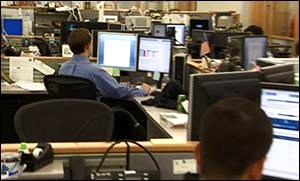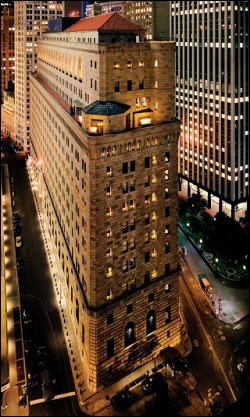The Federal Reserve Bank of New York (New York Fed) is just one of the 12 regional Federal Reserve banks around the country. But it has amassed enormous powers for itself since the Federal Reserve was created in 1913. Three of those powers dwarf all others: the ability to create money electronically at the push of a button; the accepted right to meddle in the markets; and the supervision of some of the largest bank holding companies in America.
After Wall Street blew itself up under the indulging and incompetent supervision of the New York Fed in 2008 and it was exposed that the Fed had secretly created $29 trillion in electronic money to bail out zombie banks – most of that funneled out by the New York Fed – most rational folks would have assumed that Congress would have stripped it of supervisory and money-printing powers for bailouts. Insanely, that did not happen and here we are today with the same deeply-conflicted New York Fed creating its own money to dole out $690 billion a week in super-cheap loans to unnamed securities firms while buying up $60 billion a month in the debt of the United States. (The Fed doesn't want you to call the $60 billion a month QE4 because that would strongly suggest that this is just Stage II of the continuing 2008 bailout of Wall Street and that QE-Infinity is coming.)
In addition to the unprecedented power that the New York Fed has grabbed for itself, it has a strange, incestuous and unexplained relationship with JPMorgan Chase.
For starters, JPMorgan Chase is one of the largest shareholders in the New York Fed. Yes, each regional bank of the Federal Reserve is privately owned by their member banks, the same banks being "supervised" by that regional bank. If that sounds like an insurmountable conflict of interest, it is.
Not only do the member banks own the regional Fed bank, but executives from these banks are allowed to sit on the regional Fed bank's Board of Directors, despite it being their regulator. Jamie Dimon, Chairman and CEO of JPMorgan Chase, sat on the New York Fed's Board from January 2007 through December 2012.
During that period, Dimon was publicly calling an unprecedented episode at his bank, known as the London Whale, a "tempest in a teapot." It turned out that Dimon underestimated the tempest in a teapot by $6.2 billion. That's how much the bank lost gambling in exotic derivatives in London, using the deposits of its federally-insured bank. As the public outrage grew, the New York Fed showed enormous confidence in Dimon, keeping him on as a member of its Board of Directors.
Under the Chairmanship of former Senator Carl Levin, the U.S. Senate's Permanent Subcommittee on Investigations delved deeply into the London Whale matter. Levin wrote that JPMorgan Chase "piled on risk, hid losses, disregarded risk limits, manipulated risk models, dodged oversight, and misinformed the public."
While the public outrage was playing out, William (Bill) Dudley was the President of the New York Fed. Wall Street On Paradebroke the story that Dudley's wife, Ann Darby, was receiving approximately $190,000 per year in deferred compensation from JPMorgan Chase, an amount she was scheduled to receive each year until 2021. (See As Criminal Probes of JPMorgan Expand, Documents Surface Showing JPMorgan Paid $190,000 Annually to Spouse of the Bank's Top Regulator.)

Photo of the Trading Floor at the New York Fed (Obtained by Wall Street On Parade from a Fed Educational Video.)
Just to summarize the situation in 2012 at the New York Fed: it is a primary regulator to the bank holding company of JPMorgan Chase; Jamie Dimon, the Chairman and CEO of JPMorgan Chase is sitting on its Board of Directors; JPMorgan Chase is a major shareholder in the New York Fed; the President of the New York Fed who certainly plays some role in the supervision of JPMorgan Chase, is married to a woman receiving $190,000 a year from JPMorgan Chase – money which is tied to the bank's survival; and JPMorgan Chase is under a criminal and U.S. Senate probe for using hundreds of billions of dollars of its depositors' money to gamble in high-risk derivatives in London and lose at least $6.2 billion.
Welcome to bank supervision, New York-style. And that's just the tip of the iceberg.
On November 19, 2013 the U.S. Department of Justice announced a global settlement of $13 billion with JPMorgan Chase for creating, packaging and selling toxic mortgage-backed securities. Associate Attorney General Tony West said this about the settlement: "The conduct JPMorgan has acknowledged — packaging risky home loans into securities, then selling them without disclosing their low quality to investors — contributed to the wreckage of the financial crisis. By requiring JPMorgan both to pay the largest FIRREA penalty in history and provide needed consumer relief to areas hardest hit by the financial crisis, we rectify some of that harm today." (For what was really going on here, read Matt Taibbi's report on the "$9 Billion Witness" against JPMorgan Chase that the Justice Department failed to use to prosecute the bank.)
Despite being hit with the largest fine in history for selling toxic mortgage-backed securities to public investors, the incestuous New York Fed put JPMorgan Chase in charge of its own holdings of – wait for it – $1.7 trillion in mortgage-backed securities that the New York Fed had purchased from the banks as part of its bailout of the surplus toxic waste in the banking system. As far as we can tell, that vendor agreement between JPMorgan Chase and the New York Fed has been in place since December 31, 2008 to this very day, with numerous amendments along the way. (See our 2014 report: The New York Fed Has Contracted JPMorgan to Hold Over $1.7 Trillion of its QE Bonds Despite Two Felony Counts and Serial Charges of Crimes.)
We could barely believe the hubris of this arrangement so we asked the New York Fed in 2014 to confirm that JPMorgan was serving as its custodian for these assets. It confirmed that this was correct.
At the time that we made our inquiry, JPMorgan Chase had pleaded guilty to two criminal felony counts for its role in the Bernie Madoff Ponzi scheme. The very next year it pleaded guilty to another criminal felony count for its role in rigging foreign currency trading. Last month, for the first time that anyone can remember, one of its trading desks (precious metals) was charged by the U.S. Department of Justice with being a criminal enterprise and three of its traders, including the head of that desk, were charged under the RICO statute, a law typically used to prosecute organized crime figures.
Despite all of these facts that are easily verifiable by Congress, neither the Senate nor House have called one hearing since the New York Fed began pumping money to Wall Street on September 17 of this year to the tune of hundreds of billions of dollars a week of money created out of thin air – authorized by not one public official that has been elected by the American people.

Commenti
Posta un commento